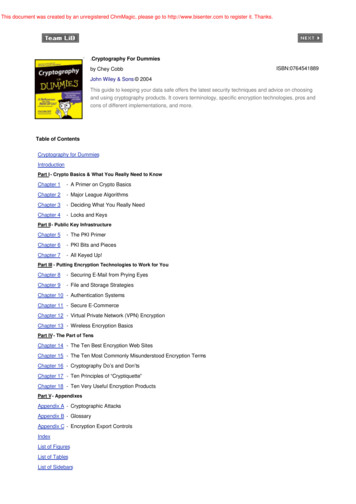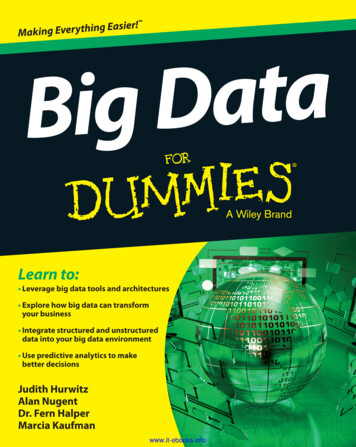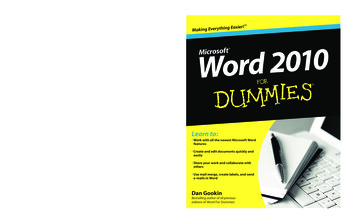
Transcription
This document was created by an unregistered ChmMagic, please go to http://www.bisenter.com to register it. Thanks.Cryptography For Dummiesby Chey CobbISBN:0764541889John Wiley & Sons 2004This guide to keeping your data safe offers the latest security techniques and advice on choosingand using cryptography products. It covers terminology, specific encryption technologies, pros andcons of different implementations, and more.Table of ContentsCryptography for DummiesIntroductionPart I - Crypto Basics & What You Really Need to KnowChapter 1- A Primer on Crypto BasicsChapter 2- Major League AlgorithmsChapter 3- Deciding What You Really NeedChapter 4- Locks and KeysPart II - Public Key InfrastructureChapter 5- The PKI PrimerChapter 6- PKI Bits and PiecesChapter 7- All Keyed Up!Part III - Putting Encryption Technologies to Work for YouChapter 8- Securing E-Mail from Prying EyesChapter 9- File and Storage StrategiesChapter 10 - Authentication SystemsChapter 11 - Secure E-CommerceChapter 12 - Virtual Private Network (VPN) EncryptionChapter 13 - Wireless Encryption BasicsPart IV - The Part of TensChapter 14 - The Ten Best Encryption Web SitesChapter 15 - The Ten Most Commonly Misunderstood Encryption TermsChapter 16 - Cryptography Do’s and Don’tsChapter 17 - Ten Principles of “Cryptiquette”Chapter 18 - Ten Very Useful Encryption ProductsPart V - AppendixesAppendix A - Cryptographic AttacksAppendix B - GlossaryAppendix C - Encryption Export ControlsIndexList of FiguresList of TablesList of Sidebars
This document was created by an unregistered ChmMagic, please go to http://www.bisenter.com to register it. Thanks.Back CoverProtect yourself and your business from online eavesdroppers—it’s easier than you think! If you were hoping for aflame-throwing watch or flying a car, we’re sorry—this isn’t James Bond’s equipment manual. Cryptography is acommon-sense way to secure stuff on the Internet, and this friendly guidebook makes it easy to understand. Discover howyou can protect information with keys, ciphers, PKIs, certificates, and more.Discover how to:Analyze off-the-shelf encryption productsDecide what type of security you needCreate and manage keysIssue digital signatures and certificatesSet up SSL for e-commerceEnable wireless encryptionAbout the AuthorChey Cobb, CISSP, author of Network Security For Dummies was Chief Security Officer for a national ReconnaissanceOffice (NRO) overseas location. She is a nationally recognized computer security expert.
This document was created by an unregistered ChmMagic, please go to http://www.bisenter.com to register it. Thanks.Cryptography for Dummiesby Chey Cobb, CISSPPublished byWiley Publishing, Inc.111 River StreetHoboken, NJ 07030-5774Copyright 2004 by Wiley Publishing, Inc., Indianapolis, IndianaPublished by Wiley Publishing, Inc., Indianapolis, IndianaPublished simultaneously in CanadaNo part of this publication may be reproduced, stored in a retrieval system or transmitted in any form or by any means,electronic, mechanical, photocopying, recording, scanning or otherwise, except as permitted under Sections 107 or108 of the 1976 United States Copyright Act, without either the prior written permission of the Publisher, orauthorization through payment of the appropriate per-copy fee to the Copyright Clearance Center, 222 RosewoodDrive, Danvers, MA 01923, (978) 750-8400, fax (978) 646-8600. Requests to the Publisher for permission should beaddressed to the Legal Department, Wiley Publishing, Inc., 10475 Crosspoint Blvd., Indianapolis, IN 46256, (317)572-3447, fax (317) 572-4447, e-mail: permcoordinator@wiley.com.Trademarks: Wiley, the Wiley Publishing logo, For Dummies, the Dummies Man logo, A Reference for the Rest of Us!,The Dummies Way, Dummies Daily, The Fun and Easy Way, Dummies.com, and related trade dress are trademarksor registered trademarks of John Wiley & Sons, Inc. and/or its affiliates in the United States and other countries, andmay not be used without written permission. All other trademarks are the property of their respective owners. WileyPublishing, Inc., is not associated with any product or vendor mentioned in this book.Limit of Liability/Disclaimer of Warranty: While the publisher and author have used their best efforts in preparing thisbook, they make no representations or warranties with respect to the accuracy or completeness of the contents of thisbook and specifically disclaim any implied warranties of merchantability or fitness for a particular purpose. No warrantymay be created or extended by sales representatives or written sales materials. The advice and strategies containedherein may not be suitable for your situation. You should consult with a professional where appropriate. Neither thepublisher nor author shall be liable for any loss of profit or any other commercial damages, including but not limited tospecial, incidental, consequential, or other damages.For general information on our other products and services or to obtain technical support, please contact our CustomerCare Department within the U.S. at 800-762-2974, outside the U.S. at 317-572-3993, or fax 317-572-4002.Wiley also publishes its books in a variety of electronic formats. Some content that appears in print may not beavailable in electronic books.Library of Congress Control Number: 2003105686ISBN: 0764541889Manufactured in the United States of America10 9 8 7 6 5 4 3 2 11O/QY/QR/QU/INAbout the AuthorChey Ewertz Cobb, CISSP, began working in computer security in 1989. Since then she has managed her owncomputer security consulting company, Cobb Associates, working for such clients as Apple Computers and SunMicrosystems. She later worked for the government, creating a secure network at Cape Canaveral, assisting in thesecurity at Patrick Air Force Base, and later as a technical security officer for the National Reconnaissance Office
This document was created by an unregistered ChmMagic, please go to http://www.bisenter.com to register it. Thanks.(NRO), which is more secretive than the NSA.During her work in security, she had the opportunity to evaluate and manage cryptosystems for private industry andthe U.S. Intelligence Agencies.Chey now writes books on computer security (Computer Security Handbook, 4th Edition and Network Security ForDummies), writes articles for magazines, and speaks at computer security conferences.DedicationTo R. W. Ewertz, Jr. He was my role model and inspiration when things got tough.AcknowledgmentsFirst of all, let me thank Andrea Boucher and Melody Layne who saw me through thick and thin and never lost faith inme (at least they never let on that they did!). I enjoy working with them both, and any writer who has the opportunity towork with them should count himself/herself lucky!Secondly, I want to thank Dave Brussin, Ryan Upton, Josh Beneloh, Jon Callas, and Dave Del Torto for setting me onthe correct path when my explanations strayed. Thanks so much for lending me your brainwork!Last, but not least, Stephen. My love, my life, and my everything.Publisher’s AcknowledgmentsWe’re proud of this book; please send us your comments through our online registration form located atwww.dummies.com/register/.Some of the people who helped bring this book to market include the following:Acquisitions, Editorial, and Media DevelopmentProject Editor: Andrea C. BoucherAcquisitions Editor: Melody LayneTechnical Editor: Tim CrothersEditorial Manager: Carol SheehanMedia Development Manager: Laura VanWinkleMedia Development Supervisor: Richard GravesEditorial Assistant: Amanda FoxworthCartoons: Rich Tennant (www.the5thwave.com)ProductionProject Coordinator: Maridee EnnisLayout and Graphics: Joyce Haughey, Andrea Dahl, Stephanie D. Jumper, Jacque Schneider, Melanee WolvenProofreaders: Andy Hollandbeck, Carl William Pierce, TECHBOOKS Production ServicesIndexer: TECHBOOKS Production ServicesPublishing and Editorial for Technology DummiesRichard Swadley, Vice President and Executive Group PublisherAndy Cummings, Vice President and PublisherMary C. Corder, Editorial Director
This document was created by an unregistered ChmMagic, please go to http://www.bisenter.com to register it. ThanksPublishing for Consumer DummiesDiane Graves Steele, Vice President and PublisherJoyce Pepple, Acquisitions DirectorComposition ServicesGerry Fahey, Vice President of Production ServicesDebbie Stailey, Director of Composition Services.
This document was created by an unregistered ChmMagic, please go to http://www.bisenter.com to register it. Thanks.IntroductionOverviewCongratulations! You’ve successfully navigated through the gazillion computer books on the bookstore shelves andfinally found just what you were looking for — a book on cryptography that you can read and actually understand! Justthumb through some of the chapters here and you’ll soon realize that you don’t need a degree in advancedmathematics, nor do you need to be the world’s biggest brainiac to understand this stuff. If you have a basicunderstanding of computers and networking, and you have an interest in increasing your data and communicationssecurity, then this is just the book for you.What I’m talking about here is cryptography — you know, crypto, geek talk, secret coding, cypherpunk’n. If you haveheard of the word cryptography, you’ll know that it is one of those subjects that many people are aware of, but very fewpeople can actually tell you what it’s all about. Frankly, just the mention of the word cryptography scares the heck outof people — even experienced network administrators! And to be honest, a lot of the books on the subject are moresuited as college textbooks than business “how-to” guides or intros to the subject, and have contributed to theatmosphere of FUD — fear, uncertainty, and doubt — about cryptography. Yep, the subject can be scary as all get-out.So, how do you decide whether or not you should use cryptography? I’ll help you answer that question with questionsand checklists. Before you go on to that chapter, however, there are many situations in which cryptography could orshould be used. Here’s a preview of some situations:Your company relies heavily upon its trade secrets to gain a competitive edge over your competitors.If an unauthorized person got access to those trade secrets, it could spell disaster for your entirecompany.You work in the health care industry and are required by the HIPAA legislation to protect personalinformation. You get notice from a federal authority that your protection methods are about to bescrutinized because there have been complaints about the way you have handled personalinformation.You’re an attorney who has been charged with prosecuting someone guilty of war crimes, drugtrafficking, or any situation where witnesses and evidence need to be fiercely protected. Obviously,you wouldn’t want your evidence or your witnesses compromised.Cryptography is a complex subject, I won’t kid you there, but it could definitely save a lot of headaches if it were usedin any of the situations mentioned above. Additionally, adding cryptography to your security doesn’t necessarily haveto be expensive or impossible to understand. That’s why I wrote this book. I’m here to take the fear out of the equationand to help you get it right the first go-round. After you read through a few sections of this book, you’ll be spouting thejargon like a true techno-geek and you’ll even be able to understand what you’re talking about.I’ll give you some advance warning, though: You’ll be seeing a lot of information about keys in this book because (andexcuse the cliché) the key to cryptography is the keys. That is perhaps the most confusing thing about cryptography —that the word “key” can be used to mean more than one thing. I wish I could change the terminology so it wouldn’t getso confusing, but I have to consider the real world, too. The terminology used in this book is based on what you arereally likely to encounter.
This document was created by an unregistered ChmMagic, please go to http://www.bisenter.com to register it. Thanks.About This BookAs I just mentioned, the subject matter covered in this book is what you are most likely to encounter in real life. Thatmeans that you can obtain enough information here to help you make decisions on cryptography: Is it right for you?What type of programs should you use? How do you set things up appropriately? After you have installed your chosensystem, you can always refer back to this book to refresh your memory as need be.Every time I introduce a new concept, I start out with really basic explanations with some analogies to help you get theidea and then, as the chapter progresses, I explain things in more detail. I promise not to get to the uber-geek level ofdetail on any particular subject because I certainly haven’t intended for the book to act as a substitute for a sedative.
This document was created by an unregistered ChmMagic, please go to http://www.bisenter.com to register it. Thanks.How to Use This BookIt’s quite simple, really. You hold the book in one hand, and use the other to turn the pages! Alternatively, you coulduse the book to prop up a broken table leg. To be honest, though, I don’t recommend the last usage because youreally won’t receive the benefits of the book if you can’t open it to read it.Seriously, I suggest that you peruse the Table of Contents and have a look at the headings and subheadings. Whenyou see something of interest, dive right in; I promise it won’t hurt. If nothing else, you can also flip through the bookand have a sneak peek at all the cartoons.
This document was created by an unregistered ChmMagic, please go to http://www.bisenter.com to register it. Thanks.What You Don’t Need to ReadOccasionally I include some deeper technical detail on certain subjects. When I include this sort of information, I makeit obvious by putting a special icon called “Technical Stuff” next to the section. It isn’t really necessary that you knowthis stuff, but I thought I’d include it just in case you were interested.So, if you see the Technical Stuff icon, you can just pass it by. Or, if you want to impress your boss, you can memorizethe information and impress him with your knowledge!
This document was created by an unregistered ChmMagic, please go to http://www.bisenter.com to register it. Thanks.Foolish AssumptionsWhen you are writing for a mass audience (as I am here), it’s difficult to gauge the level of aptitude. Because I didn’tknow ahead of time what you know and what you don’t know, I’ve had to make certain foolish assumptions. So as notto insult your intelligence, here are the assumptions I’ve made:You’d really like to know more about cryptography.You’re not intimidated by computers, computing, or networks.You are connected to an Internet, whether through your job, DSL or cable modem at home, or adial-up account.You are interested in security and, in particular, securing your data and communications.You are aware that your e-mail messages can be read by almost anyone in the world (besides theintended recipient).You’re aware of the fact that unauthorized persons can get access to your computer and read, steal,and change your files.You’re capable and/or authorized to install computer software programs.You don’t expect this book to make you an instant expert; I give you enough information to get youstarted and to be able to speak intelligently with others on the subject.
This document was created by an unregistered ChmMagic, please go to http://www.bisenter.com to register it. Thanks.How This Book Is OrganizedI’ve assembled this book into distinct and separate “parts” and each part focuses on a particular aspect ofcryptography. This will help you to find the correct level of explanation for the questions you need answered. It’s notnecessary to read each part completely in order to get an idea of what’s going on. Here’s a brief description of each ofthe parts.Part I: Crypto Basics & What You Really Need to KnowThe title says it all! Algorithms and ciphers explained. An introduction to keys and how they are used in cryptography.Help with deciding what you really need. And I discuss keys in depth (because they are really, really important!).Part II: Public Key InfrastructurePublic Key Infrastructure, also known as PKI, is as it says, an infrastructure. That is, basic facilities, services, andinstallations needed for the functioning of a cryptographic system. It’s not something that comes complete in one box;you generally have to build this system with servers, software, and connections to a public network like the Internet.This part goes into what PKI does, how it does it, what you need to do it, and why you would want to build such asystem.Part III: Putting Encryption Technologies to Work for YouNow that you’ve decided that you really should be using cryptography as an additional security measure, here are allthe things you can use it for. I discuss e-mail systems, file storage, and authenticating users of your systems. Inaddition, I have a look at e-commerce on the Web, the use of VPNs, and last, but not least, wireless security. Wirelesssecurity is a hot topic right now!Part IV: The Part of TensDo you like lists? Do you like tips, tricks, and resources for additional information? Included in this part is lots ofinformation that is sure to inform and amuse you! I’ve included Web sites, software, and common mistakes, amongother goodies.Part V: AppendixesHere you get three appendixes with even more information! In addition to a handy glossary of terms you’ll read about, Ialso tell you all kinds of stuff about crypto attacks and encryption export controls.
This document was created by an unregistered ChmMagic, please go to http://www.bisenter.com to register it. Thanks.Icons Used in This BookTechnical Stuff You’ll probably notice that I put a lot of these in the book. If you really want to impress your geekyfriends, this is the stuff to read. It’s not really necessary that you read every one of these, but you might be amazed atwhat you’ll learn.Tip These are the things you always want in a hurry. They sometimes make the job easier or faster by suggestedshort-cuts for common tasks.Warning Basically, this icon means Don’t Do This! Tread softly, pay attention, and be very, very sure of what you aredoing. Always have a back-up plan in case things don’t go well.Remember We all need a little nudge now and then to jog our memory. That’s exactly what these sections do. After awhile you won’t need these reminders as tasks become second nature to you.
This document was created by an unregistered ChmMagic, please go to http://www.bisenter.com to register it. Thanks.Where to Go from HereStart flipping through the book and dive in where something catches your eye. Like I’ve said before, it’s not necessaryfor you to read this book in any particular order, so you’re free to dive in anywhere to get your feet wet.Occasionally I suggest software that you may want to try. Go to the site I mention and download the file and install iton your system. I recommend that you install these programs on test machines first, to see how they work and to see ifthey conflict with anything else you already have. Playing around with the software is one of the best ways tounderscore the knowledge I impart here. In any case, enjoy yourself!
This document was created by an unregistered ChmMagic, please go to http://www.bisenter.com to register it. Thanks.Part I: Crypto Basics & What You Really Need to KnowChapter ListChapter 1: A Primer on Crypto BasicsChapter 2: Major League AlgorithmsChapter 3: Deciding What You Really NeedChapter 4: Locks and KeysIn this part . . .This is the part to get you started — get you started so you can attend that meeting on cryptography and encryptionproducts and sound like you know what you’re talking about. This is the section that will make your boss realize thatyou’re an indispensable employee. And if you are the boss, this part will give you the information you need to workyour way through the labyrinth of confusing jargon and new technology.In addition to giving you the basic information to be able to understand what the software and hardware vendors arethrowing at you, the basics of algorithms and keys are explained. There’s also a complete chapter to help you decidewhat you need by giving you situations in which encryption is used and the technology needed to make it happen. Youdon’t have to start here if you don’t want to, but if you’ve never encountered cryptography or encryption before, Isuggest you at least give it a browse.
This document was created by an unregistered ChmMagic, please go to http://www.bisenter.com to register it. Thanks.Chapter 1: A Primer on Crypto BasicsIn This ChapterIt’s not just for spies anymoreBasic information on early cryptographyCipher, cipher, who’s got the cipher?It’s all hashed upWhat are cryptosystems?Some everyday usesElitist attitudes towards cryptographyComputers and use of the Internet have fostered new interest in cryptography partly due to the new emphasis onpersonal privacy. Little did I realize that in our efforts to make it easy for computers to share stuff, it would make it easyfor other people to see all of our personal stuff, too. Perhaps you’ve discovered for yourself that it is far too easy forunknown persons to read your e-mail, private documents, love letters, financial information, and so on. The Internet istruly the Global Village . . . a village where everyone can see what you do and hear what you say. The good news isthat you can use cryptography to protect yourself from the eavesdroppers and Peeping Toms of the village.Not only can cryptography scramble your files, but it can also be used to prove who you are (and maybe who youaren’t!). Cryptography can be used to alert you if the contents of a file have been changed, attest to the identity of theperson who sent you a message, keep online communications safe and secure, and, of course, hide important data.And the best news of all is that not every cryptographic solution is expensive, and you don’t need to be a rocketscientist to incorporate crypto solutions into your network.
This document was created by an unregistered ChmMagic, please go to http://www.bisenter.com to register it. Thanks.It’s Not about James BondThere’s no need for fancy gizmos, fast cars, or beautiful women. As nice as those may be (for some!), the world ofcryptography can be used on even low-tech systems. Forget the cloak and dagger and put away your raincoat andfedora — most cryptography is done out in the open now. The special programs and codes used to scramble data areavailable for all the world to see. In fact, having them out in the open helps make cryptography more secure becausemore people can test for weaknesses.Because cryptography is usually associated with spies, secret messages, and clandestine meetings, you might havethought that cryptography stopped being used at the end of the Cold War. Believe it or not, its use is actually on therise. I think that’s partially due to more awareness of personal identity theft and also because more is being written inthe media about how data needs more protection that a common PC gives you.Cryptography is about scrambling data so that it looks like babble to anyone except those who know the trick todecoding it. Almost anything in the world can be hidden from sight and revealed again. The magician DavidCopperfield has made his living from hiding enormous things from plain view — like elephants and the Statue ofLiberty — and then magically revealing them again. Any magician will tell you that in order to make things disappearand appear again, you have to have a plan of action — a formula or recipe — to make the magic work. Although youcan’t directly equate magic acts with cryptography (although cryptography may seem like magic), there is a similaritybetween magic and cryptography in that they both need to have a formula in order to work correctly time after time.Go with the rhythmIn cryptography, the magic recipe for hiding data is called an algorithm. An algorithm is a precise set of instructionsthat tells programs how to scramble and unscramble data. A simple algorithm might read like this:Step 1:Step 2:Step 3:Delete all instances of the letter “e” in the dataReplace the letter “t” with the number “7”Reverse the order of the data and rewrite it from the end to the beginningNow, this is just me playing around with what a simple algorithm might look like, just so you can get an idea of what I’mtalking about. The steps above are not an actual algorithm; it’s my pretend algorithm of the week. Algorithms used inprograms today are mathematical functions with the instructions written in programming code.Here’s just a portion of a real algorithm called DES (Data Encryption Standard) that was adopted by the government in1977. DES is a block cipher that transforms 64-bit data blocks under a 56-bit secret key by means of permutation andsubstitution. (You’re not meant to understand that last sentence yet!) So, here is just a tiny, tiny bit of the DESalgorithm:Get a 64-bit key from the user. (Every 8th bit is considered a parity bit. For akey to have correct parity, each byte should contain an odd number of "1" bits.)Calculate the key schedule.Perform the following permutation on the 64-bit key. (The parity bits arediscarded, reducing the key to 56 bits. Bit 1 of the permuted block is bit 57 ofthe original key, bit 2 is bit 49, and so on with bit 56 being bit 4 of theoriginal key.)Permuted Choice 1 (PC-1)57 49 41 33 25 17 91 58 50 42 34 26 1810 2 59 51 43 35 2719 11 3 60 52 44 3663 55 47 39 31 23 157 62 54 46 38 30 2214 6 61 53 45 37 2921 13 5 28 20 12 4In actuality, the remainder of the DES algorithm could easily fill six or seven pages! What I’ve shown you is just a smallportion of the entire recipe. Interestingly, although DES is complex, it was found to have serious flaws that were
This document was created by an unregistered ChmMagic, please go to http://www.bisenter.com to register it. Thanks.exposed in 1998. These flaws lead teams of cryptographers to re-work DES because the original algorithm could becracked and was no longer considered safe to use. The algorithm the cryptographers came up with to replace DES iscalled 3DES (Triple DES). I’ tell you more about 3DES in Chapter 2 about algorithms.Rockin’ the rhythmThe reason that algorithms are so complex is to ensure that they can’t be easily broken. It wouldn’t do a spy any goodto send out a secret message if everyone in the world could crack the code and read it. The algorithms we use todayhave been tested by crypto experts to check their strength, but sometimes it takes years to find the fatal flaw. Whenthis happens, notices are sent out via vendors and the media to let users know that they may need to make somechanges in encryption programs they are using.Most algorithms are mind-numbingly complex mathematical equations — or at least they appear that way to me!Fortunately, you normally don’t have to deal with the algorithm itself — the encryption software does that for you. Forthat reason, I’m not going to dwell on the math behind the science. Just like you don’t need to be a mechanical geniusto drive a car, you don’t need to be a mathematician to be able to use encryption products. (Hooray!) For mostencryption products, the most difficult part is the initial setup. After that, the scrambling and unscrambling is mostlydone without your interaction.There are tons of different algorithms used in the world of cryptography. Why? For the same reason you use differentrecipes to make a cake. Some recipes are better, some recipes are easier, and some recipes depend on time andcare to make them turn out right. The same thing happens with algorithms — we need to use faster, easier, strongeralgorithms, and some are better than others at accomplishing the task. It all depends on your needs as to whichalgorithms you’ll eventually use in your system.There are also tons of arguments as to what makes a good algorithm and what makes a bad algorithm. Get any threecrypto geeks in a room to discuss the differences and, chances are, they’ll still be arguing a week later. Goodalgorithms are generally referred to as strong crypto and bad algorithms are called weak crypto. You’ll find argumentsgalore in newsletters and mail lists that attempt to describe why one algorithm is better than the other. You’ll need toknow at least the basics on how to tell one from the other, so you’ll be seeing information on good versus bad later onin this book. Often the problem has more to do with the installation and setup of the software than problems with theproduct or the algorithm.Starting with this chapter, I give you the plain, old-fashioned basics that are good for you to know. This subject is reallycomplex, and humongous tomes have been written by others, but that’s not what I’ll be doing here. I know you’re nottrying to get a college degree on the subject — you just want to know enough to buy the right stuff, install it correctly,and be able to use it. If that’s what you want, then you’ve got the right book!
This document was created by an unregistered ChmMagic, please go to http://www.bisenter.com to register it. Thanks.Getting to Know the Basic TermsI’m going to start you off with some introductory terms. These are not meant to confuse you; rather, they are meant togradually introduce you to some of the lingo used in cryptography.Encrypt: Scrambling data to make it unrecognizableDecrypt: Unscrambling data to its original formatCipher: Another word for algorithmKey: A complex sequence of alpha-numeric characters, produced by the algorithm, that allows you toscramble and unscramble dataPlaintext: Decrypted or unencrypted data (it doesn’t have to be text only)Ciphertext: Data that has been encryptedCryptography through the agesMaking secret me
Chey now writes books on computer security (Computer Security Handbook, 4th Edition and Network Security For Dummies), writes articles for magazines, and speaks at computer security conferences. Dedication To R. W. Ewertz, Jr. He was my role mod










